Brake fluid is an essential aspect of a vehicle. But it can become “an out of sight, out of mind” component, which can further invite complications.
Since brake fluid works extremely hard to keep you and the vehicle safe on the road, it can soon become worn out. When this happens, the brake stops working properly. And it can be dangerous.
Table of Contents
Is Brake Fluid Flammable?
Brake fluid is generally considered to be flammable. It is typically composed of a mixture of glycol-based fluids and can ignite if exposed to high temperatures or an open flame. It is important to handle brake fluid with care and keep it away from heat sources to prevent the risk of fire.
What is the Brake fluid?
Brake fluid is a liquid chemical used in cars. This liquid is added to increase the foot force on the break, which is turned into pressure on the car’s brake. Without the presence of a foot brake, you would require more than just a foot to stop the car.
The brake fluid mainly converts the force. Also, it amplifies the braking force and makes it easy to stop a car.
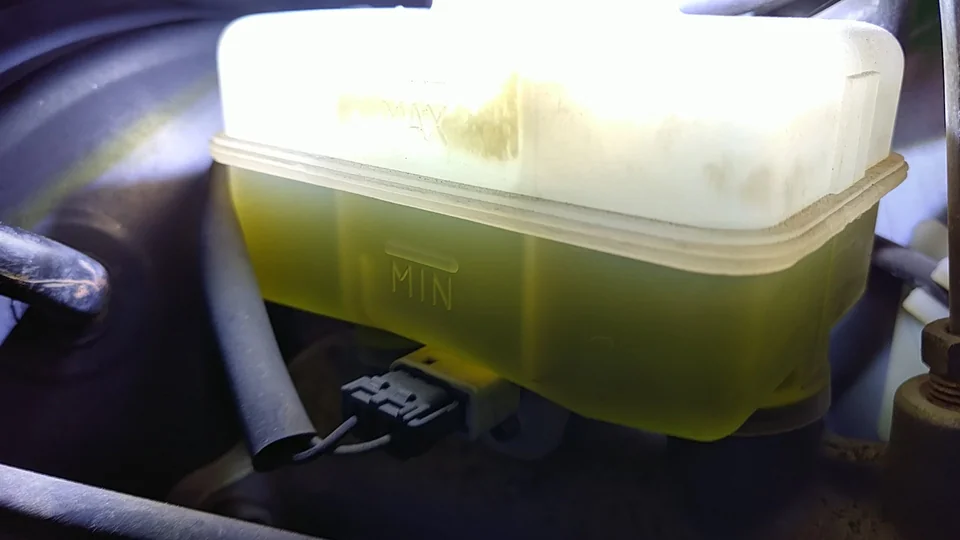
In fact, a Brake fluid is a hydraulic fluid that moves the particles of your car’s braking method. If you don’t have brake fluid, you will not be able to stop your car. There are a lot of vehicles that need to use brake fluid. For instance, brake fluids are in cars, buses, motorbikes, trucks, and even in some bicycles as well. As you want to secure your car brakes proceed to function appropriately, you have to keep various things in mind.
Whether you are going to fix the brake fluid by yourself or not, you should have some sort of knowledge to deal with brake fluid. Otherwise, your vehicle might be in danger! So, be cautious about it. And, to get your question, is brake fluid flammable or not, keep reading the article until the end.
What are the types of Brake Fluid?
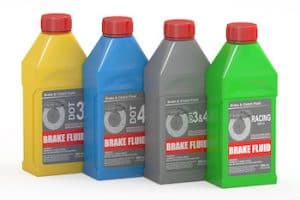
Literally, there are three major varieties of brake fluid available in the market. The three models are DOT3, DOT4, and DOT5 respectively. And you can keep DOT3 and DOT4 in one section as they come with glycol-based fluids. On the other hand, the DOT5 is based on silicon.
The crucial point is that DOT3 and DOT4 can absorb water, but the DOT5 can’t.
To tell about one of the most significant aspects of brake fluid is the boiling point of it. That is to say, Hydraulic systems depend on a compressed fluid to disseminate force. Liquids are usually condensed at the time when gases are compressible. If the brake fluid becomes a gas or gets boiled, it will be unable to transmit force properly. In this way, your brakes can be somewhat or entirely disabled.
It is sure that you won’t hope to lose your brake while driving down a mountain. This is why you have to be careful about the characteristics of the brake fluids.
Is DOT 3 Brake Fluid Flammable?
DOT 3 brake fluid can easily withstand very cold and high temperatures without thickening or boiling. Typically, the boiling temperature of DOT 3 brake fluid is 250° C.
Generally, it is yellow to amber in color. While it’s slightly soluble in water, doing so is discouraged. That’s because water can degrade the brake fluid quality.
DOT 3 brake fluid is moderately flammable as it is glycol-based. It has a low flashpoint of 230 degrees Fahrenheit.
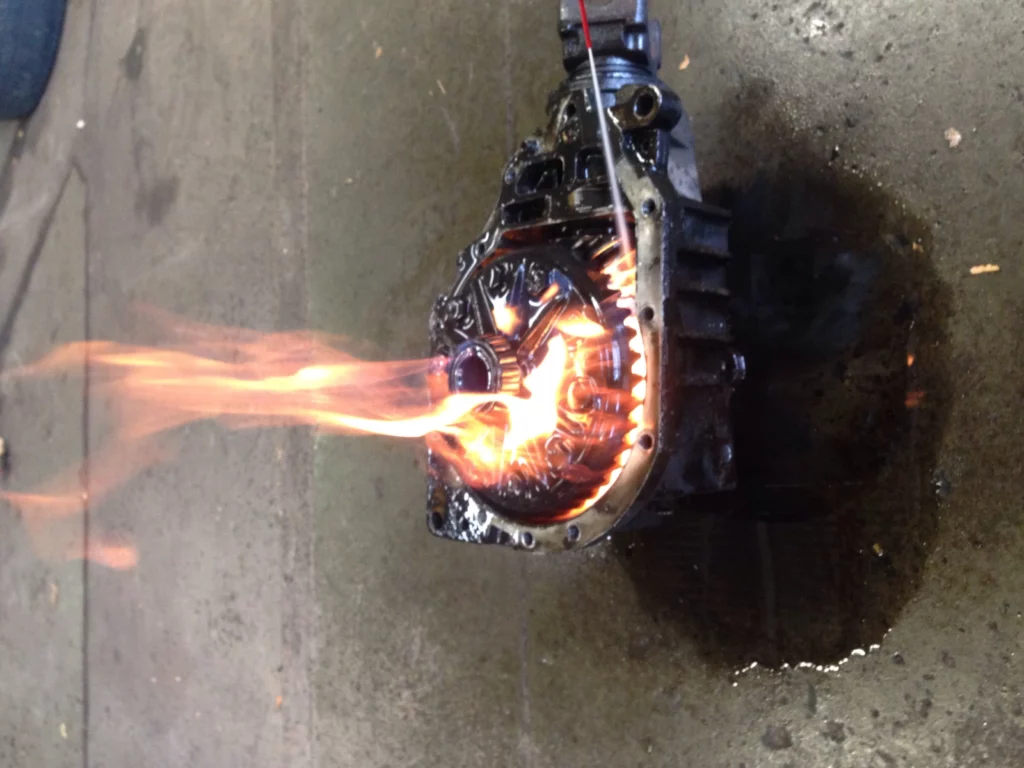
Is DOT 4 Brake Fluid Flammable?
The DOT 4, DOT 4+, and DOT 5.1 brake fluid either use borate ester or glycol ether. That means if this brake fluid is exposed to higher temperatures, it will burn. Talking about its flashpoint, it is 210-375-degrees Fahrenheit. So, as compared to silicone-based brake fluid, this one will burn quickly.
Is DOT 5 Brake Fluid Flammable?
As compared to other types, the DOT 5 is highly flammable. It is silicone-based and has a higher flashpoint. So, if there is a collision, this fluid will ignite spontaneously.
Most manufacturers do not recommend DOT 5 brake fluid as it does not absorb moisture. It will give you spongy pedals, but if there is moisture in the system, the area where the moisture lands will start to erode.
When Does Brake Fluid Catch Fire?
You might know that brake fluid becomes flammable when exposed to higher temperatures. But do you know when it catches on fire? Well, it catches on fire after crossing the flashpoint. That’s when it vaporizes and burns.
But it’s important to remember that different fluids start burning at different temperatures. On average, the brake fluid ignites at a temperature above 540 to 675 degrees Fahrenheit.
Certain times brake fluid can burn on its own. Out of the three brake fluid types, it is the DOT 3 that is more flammable.
Moisturizing in the Brake Fluid
As said earlier, brake fluid is a kind of hydraulic fluid. So, it wants to consume moisture. But, unfortunately, If the brake fluid consumes more moisture, then it degrades tremendously. Provided that, you don’t want your brake fluid’s degradation, you have to keep the brake fluid distant from water. Although, the fluid will still consume moisture from the air gradually. So, it is sure that the fluid will come to be further degraded until it becomes totally ineffective.
Therefore, it is not a solution to let the brake fluid be degraded slowly but surely. Let’s talk about how can we eliminate this problem by replacing Brake Fluid.
Signs You Need Brake Fluid Change
Brake fluid is essential for modern vehicles, but it can burn out, contaminate or deplete over time. When this happens, you can’t press the brakes properly.
Soft and Spongy Brake Pedal
Does the car brake feel soft, bouncy, or spongy when you press it? Are you required to hit the brakes hard to stop your vehicle? If so, you must consider getting brake fluid flush.
That’s because when the brake fluid level decreases, it causes air to fill the gaps. It is what makes the brake soft. The problem with spongy brakes is that they can lead to serious accidents.
ABS Dashboard Lighting
Another sign that indicates that your vehicle needs brake fluid change is the ABS dashboard. Actually, ABS dashboard lighting indicates a problem with anti-lock braking. When this issue arises, the wheel stops locking up during braking.
Long story short, low brake fluid turns on the ABS dashboard lighting to help you safely press brakes. Thus, you must change the brake fluid quickly.
Ineffective Braking Performance
In an emergency, delay or difficulty slowing down a vehicle can result in serious accidents. Also, it’s a sign that your vehicle’s brakes need servicing, and you need to change the brake fluid flush.
Besides brake fluid, brakes become ineffective due to worn tire tread, struts, or shocks. If you notice this problem, you can contact professionals to get help.
Strange Noise or Smell
Do you hear a strange noise or smell when you hit the brake? It can happen due to low brake fluid or similar brake system issues. Usually, you will hear strange noises like grinding or scraping.
Talking about the smell, you will get a burning scent after hard braking. It indicates that you have a burnt-out brake system. If this happens, you must bring your vehicle to a safe place so that the brake can cool down.
While it’s cooling down, you can contact a professional to fix the issue. If this issue is left unattended, it could result in brake failure.
Routine Maintenance
If you do not notice any of the signs mentioned above, you can get the brake fluid change during routine maintenance. On average, you should change the brake fluid every 30,000 miles or 2 years.
Besides this, routine maintenance depends on the way you drive your vehicle. For instance, you would not require frequent brake fluid flush if you drive longer routes. But if you drive shorter distances, you will not need frequent brake fluid flush.
How Often Should I Replace the Brake Fluid?
If it’s not too serious, you should replace Brake fluid not as much as once a year. Plus, it’s not essential to change it more than two times in a year. So, you will have to totally wash the old brake fluid out of the car. Then, you will be able to replace it with fresh brake fluid.
Let see how it is done.
How Should You Replace the Brake Fluid?
To make this operation, two people are to stay along. One person will push the brake pedal. Plus, another one will deal with the real draining. If you are not a technician or don’t know how to do it perfectly, it’s better to take the help of the professionals.
If you’re looking for a Replacement kit for brake fluid, then I recommend you to use this product from Amazon.
How to check and add Brake Fluid?
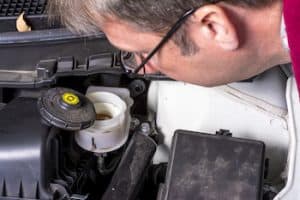
To check Brake Fluid, you can check my recommended testing kit from Amazon.
You have to test your brake fluid grades at the minimum one time in a month. In the beginning, you have to fix your brake master cylinder. And, check whether there are any concerns about its location, review the vehicle’s manual guide. Provided that, your cylinder is transparent, just notice the markers. On the other hand, while it is not transparent, unlock the cylinder. You will find the markers situated on the inside of the cylinder.
Moreover, If you find a minor falling off brake fluid grades, just splash in extra brake fluid as far as the brake fluid grades achieve the “full” marker. On the other hand, while the declining is more, you will get a leakage in the braking portion. Remember, this is a serious case. Take your car to a car mechanic without any delay.
Check DOT Ratings of Brake Fluid
While you are to add or replace your car’s brake fluid, always keep it in mind that the brake fluid’s DOT rating has to be checked! Okay, what’s a DOT rating then?
Indeed, Dot rating is a rating provided by the US Department of Transportation in order to clarify- how the brake fluid responds to warm up and to get moisturized.
So, if you want to ensure, your brakes proceed to work perfectly, you never should use separately rated brake fluids. You can’t even do this mix while you’re totally renovating your brake fluid.
Check the supporting kit from Amazon.
And the ultimate question,
Is Brake Fluid Flammable?
Yes, it is. Brake fluid is flammable and it burns slowly. All three major variations of brake fluids including DOT3, DOT4, and DOT5 do burn. Although, they don’t burn like the explosive such as gasoline. But, they will burn in slow motion such as vegetable oil, or like a little faster than candle wax.
Overall, Brake fluids are remarkably flammable, harmful as well as corrosive.
Brake fluid is non-compressible. Also, it has fast air releasing capacity, which makes it ideal for power emission.
Brake Fule’s Flammability
If you want to know why brake fluid is flammable, you need to know its elements. You can find several brake fluid types and different tags.
You can also find DOT 5. While it has a glycol-base, its standards are similar to the DOT 5 as it has properties of silicone-based hydraulic fluid. The brake fluids that have ethyl-glycol-base are more likely to start a fire.
While silicone-based brake fluid supports burning, its flammability is less explosive than other volatile fluids. In a nutshell, it burns similarly to vegetable oil. Meaning it supports a flicker of flame.
A point to note here is that brake fluid will not burn under normal temperatures. But if the brake fluid burns during an accident, the burning can easily be spread to rubber parts as well.
Also, brake fluid is corrosive and toxic. Moreover, it is capable of eating some metal parts as well. The glycol-based brake fluid can even peel off the car paint when it comes to contact.
Overall, Brake fluids are remarkably flammable, harmful as well as corrosive.
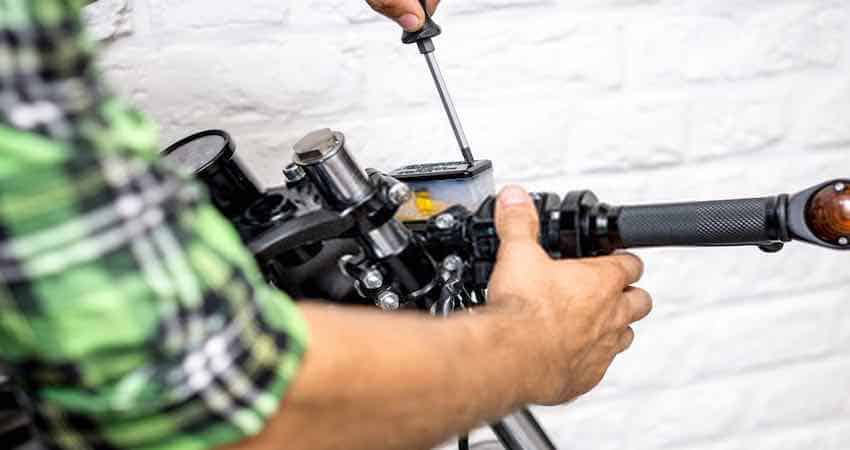
Safety Precautions While Using Brake Fluid
Since Brake fluids are very flammable, toxic, and corrosive, you should maintain some safety precautions for it. By getting in your car, the brake can melt paint. So, you should at least maintain the below safety tips always:
- Resist Brake fluid from fires and electric ports.
- Using gloves is a must for working with the fluid. Look which hand gloves usually I use to deal with brake fluid. Check the gloves from Amazon.
- Provided that it gets to your skin, clean it off instantly.
- Be especially cautious if there are small kids because children are supposed to be affected more than adults.
Thus, always keep safe from brake fluid. And ensure that you and your family don’t be affected with it.
Disposing Brake Fluid
As you know, brake fluid is remarkably flammable and harmful. Thus, you must carefully dispose of brake fluid. Remember that you must never pour the used brake fluid into the toilet as it’s hazardous.
You must look for a proper way for waste management. In case there is a spill, you must wipe it off quickly. Also, the brake fluid must not be indigested as it is toxic.
All in all, you must properly handle the brake fluid. Also, you should avoid taking it near a fire source.
Frequently Asked Questions
What temperature does brake fluid ignite?
Brake fluid typically ignites at a temperature of 230°F. However, this exact temperature can vary depending on the specific type and formulation of the brake fluid, as well as any contaminants present.
Is brake fluid DOT 3 flammable?
Yes, brake fluid DOT 3 is flammable. It has a lower boiling point than DOT 4 and DOT 5, making it more susceptible to ignition under high temperatures. However, it typically requires a high heat source to ignite.
Is DOT 4 brake fluid flammable?
DOT 4 brake fluid is also flammable, though it has a higher boiling point compared to DOT 3. This makes it more resistant to ignition, but it can still ignite under extreme temperatures or if exposed to an open flame.
What is the flashpoint of brake fluid?
To know the flammability of liquids, it’s essential to check the flashpoint. It’s the temperature at which liquid turns into vapor and sustains a flame. As far as brake fluid is considered, its flashpoint is 210-375 degrees Fahrenheit. So you see, the flashpoint of brake fluid is high, which means it’s less flammable than other volatile liquids.
Does chlorine and brake fluid explode?
If you mix chlorine and brake fluid, you can expect an explosive reaction. Chlorine is a powerful oxidizing agent. When you mix it, you will notice a period of dormancy. Then there will be a hissing sound and explosion with fire.
Is brake fluid good for rust?
Honestly, brake fluid is good for rust because it can efficiently dissolve rust. It is possible because brake fluid is a PAG, i.e., it’s an aromatic ester capable of removing paint, rust, and similar things.
Let’s Wrap Up!
This is everything about brake fluid and its characteristics. In the post, we’ve tried to answer every relevant question and show all relevant information. Plus, as you can know everything about brake fluid we have covered, what’s the brake fluid, what types they come with, how often you should replace the brake fluid, how to replace the brake fluid, how to check it and at last what are the safety tips for it.
If there are any lacking in our article, indicate those in the comments section below. Or, if you have anything to ask us, feel free to do so. We will be quickly back to you with the relevant answer.
To help you avoid any accidents, we have also listed five signs that you can see to understand whether your vehicle needs brake fluid flush or not. So, check for these signs today and mark yourself safe from any serious injury caused by low brake fluid.
